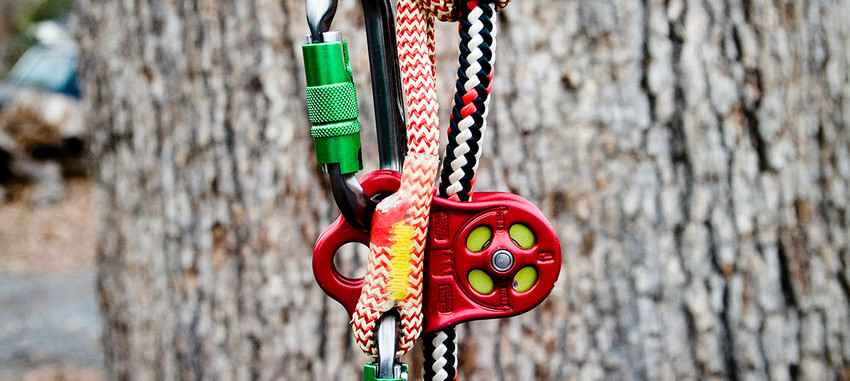TFTC #6 Maximizing your Climbing System Efficiency
Sherrilltree Oct 11th 2018One quote I heard early on and have kept in the back of my mind comes from Tony Tresselt. Tony is a well experienced arborist, trainer, author, and all-around great guy. The guy is wicked with a chainsaw and he has probably forgotten more than I will ever learn. During a conversation, he said:
“There is a difference between 10 years of experience and six months of experience repeated 20 times.”
That is quite a powerful concept.
We should always be looking to advance our knowledge and put it into practice in the field. Identifying opportunities and searching for a solution should be part of our thought process. Nothing wrong with using what we have been taught as you have to start somewhere. Venture out and look to further your knowledge.
In the last installment of Tips From the Canopy, we discussed friction savers such as ring and ring friction savers and how these pieces of gear can be extremely helpful with managing friction and providing efficiency. To build on that, we are going to look at the best ways to increase efficiency within our climbing system.
When tweaking your climbing system, keep in mind your comfort level and — ultimately — your safety. Changing too many things at once can adversely affect how you feel while tied in, leading to hazards and mistakes while in the tree. Being uncomfortable is not ideal, so we want to avoid this. It is not necessary to throw a bunch of new gear into your climbing system to increase efficiency. When you gradually introduce small changes, you can increase efficiency while allowing yourself to become accustomed to the change. With these gradual changes, we are able to fully understand the effects of the change in your system.
Let’s start with a basic or traditional system utilizing a Blake’s Hitch. Anyone who has used this system can appreciate the desire to increase efficiency. We can find a lot of opportunity to increase efficiency and production at the same time. The hip thrust can certainly be physically demanding. Ergonomically, the system can put unnecessary wear and tear on your body.
This is not to say this system does not have its place in the industry!
A large majority of arborists learned to climb on this system. It is not a bad idea by any means to know how to use this type of system and be comfortable using it. It oftentimes proves quite handy, for example, when wanting to use the tail end of your climbing system to create an (M) system for work positioning.
Breaking this system down and how we use it to ascend becomes quite involved: Pulling yourself up the climbing line, holding your weight with one hand while advancing the hitch with the other hand repeating over and over until you reach the desired position in the tree...
...Needless to say, this can make for a strenuous ascent.
But what if we add just one piece of gear to decrease the number of the movements involved during ascent?
By simply adding an inexpensive micro pulley, we can increase efficiency by taking the need to manually advance the hitch out of the equation. Now, instead of hauling ourselves up the climbing line and then holding ourselves with one hand to advance the hitch, we can let the pulley advance the hitch for us.
Although this is a simple addition, the benefits are quite surprising. For climbers currently using this system it is a must have addition. Besides the obvious benefits of efficiency, adding just one piece of gear creates a scenario where the user is not overwhelmed with a significant change to their normal climbing system. This is not to say that you can’t change multiple pieces of gear in a system or change to a totally different system altogether. But, by adding or changing only one piece, we can see and feel the difference and take our time getting used to the change without drastically affecting our comfort level.
Increasing efficiency while ascending is only one area of opportunity with this type of system.
Many times, we need to change our tie-in point while in the tree. With this type of system, we find that we are forced to untie and re-tie knots and hitches if we want to advance our system or change our tie-in point. Again, by adding just a single piece of gear, we can solve this problem and improve efficiency. A single eye split tail allows us to create a system where tying and untying knots and hitches is no longer necessary. We can simply clip in and out from the split tail, and quickly reconnect after advancing our climbing line.
Take the above examples and apply it to your current system, no matter how basic or advanced. The quest for efficiency is one that is easily obtainable if we allow ourselves the opportunity. There is no shortage of solutions available to us.
We should look to make it better and increase efficiency of our climbing system, which in turn provides the opportunity to minimize wear and tear on our bodies and increase production. If you can make it happen, carve out some time for seminars in your area. Take a weekend with your crew or family and attend an event link Arborfest EXPO or the TCI Expo.They're amazing opportunities to meet other like-minded individuals in our industry and check out the latest and greatest gear. Plenty of learning opportunities are available as well from just walking the floor, vendors, manufacturers, the demo tree and a list of seminars that cover a multitude of topics.
Look at your system, and see if there is a way to help yourself. Again, swapping, adding or changing just one piece of gear can prove very worthwhile. Take it low and slow and have fun!
Climb safe. Cut safe.

